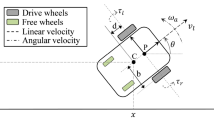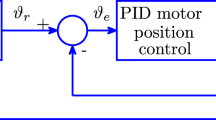Abstract
This paper studies unknown input observer design for discrete-time Takagi-Sugeno fuzzy systems. The proposed unknown input observer has a new structure that can be applied to Takagi-Sugeno fuzzy systems with nonlinear output equation. We derive the design conditions of the proposed unknown input observer based on Lyapunov function and convert them into a set of linear matrix inequalities. Numerical simulations of a vehicle lateral dynamics are given to illustrate the effectiveness of the proposed method.
Similar content being viewed by others
References
C. K. Ahn, P. Shi, and M. V. Basin, “Two–dimensional dissipative control and filtering for roesser model,” IEEE Trans. on Automatic Control, vol. 60, no. 7, pp. 1745–1759, 2015.
K. Zhang, B. Jiang, and P. Shi, Observer–based Fault Estimation and Accomodation for Dynamic Systems, vol. 436, Springer, 2012.
S. Guo, F. Zhu, and L. Xu, “Unknown input observer design for Takagi–Sugeno fuzzy stochastic system,” International Journal of Control, Automation and Systems, vol. 13, no. 4, pp. 1003–1009, 2015.
Y. Li, H. R. Karimi, M. Zhong, S. X. Ding, and S. Liu, “Fault detection for linear discrete time–varying systems with multiplicative noise: the finite–horizon case,” IEEE Trans. on Circuits and Systems I: Regular Papers, vol. 65, no. 10, pp. 3492–3505, Oct. 2018.
X. Li, F. Zhu, and J. Zhang, “State estimation and simultaneous unknown input and measurement noise reconstruction based on adaptive H¥ observer,” International Journal of Control, Automation and Systems, vol. 14, no. 3, pp. 647–654, 2016.
X. Yu, P. Li, and Y. Zhang, “The design of fixed–time observer and finite–time fault–tolerant control for hypersonic gliding vehicles,” IEEE Trans. on Industrial Electronics, vol. 65, no. 5, pp. 4135–4144, 2018.
Y. Hou, F. Zhu, X. Zhao, and S. Guo, “Observer design and unknown input reconstruction for a class of switched descriptor systems,” IEEE Trans. on Systems, Man, and Cybernetics: Systems, vol. 48, no. 8, pp. 1411–1419, Apr. 2017.
W. Zhang, H. Su, F. Zhu, and G. M. Azar, “Unknown input observer design for one–sided Lipschitz nonlinear systems,” Nonlinear Dynamics, vol. 79, no. 2, pp. 1469–1479, 2015.
K. Zhang, B. Jiang, and V. Cocquempot, “Fuzzy unknown input observer–based robust fault estimation design for discrete–time fuzzy systems,” Signal Processing, vol. 128, pp. 40–47, 2016.
S. Mondal, G. Chakraborty, and K. Bhattacharyy, “LMI approach to robust unknown input observer design for continuous systems with noise and uncertainties,” International Journal of Control, Automation and Systems, vol. 8, no. 2, pp. 210–219, 2010.
D. Ichalal and S. Mammar, “On unknown input observers for LPV systems,” IEEE Trans. on Industrial Electronics, vol. 62, no. 9, pp. 5870–5880, 2015.
W.–J. Chang, L.–Z. Liu, and C.–C. Ku, “Passive fuzzy controller design via observer feedback for stochastic Takagi–Sugeno fuzzy models with multiplicative noises,” International Journal of Control, Automation and Systems, vol. 9, no. 3, pp. 550–557, 2011.
J. Cheng, J. H. Park, Y. Liu, Z. Liu, and L. Tang, “Finitetime H¥ fuzzy control of nonlinear Markovian jump delayed systems with partly uncertain transition descriptions,” Fuzzy Sets and Systems, vol. 314, pp. 99–115, 2017.
D. Zhai, L. An, J. Dong, and Q. Zhang, “Switched adaptive fuzzy tracking control for a class of switched nonlinear systems under arbitrary switching,” IEEE Trans. on Fuzzy Systems, vol. 26, no. 2, pp. 585–597, 2018.
H. D. Choi, C. K. Ahn, P. Shi, L. Wu, and M. T. Lim, “Dynamic output–feedback dissipative control for T–S fuzzy systems with time–varying input delay and output constraints,” IEEE Trans. on Fuzzy Systems, vol. 25, no. 3, pp. 511–526, 2017.
M. Shen and D. Ye, “Improved fuzzy control design for nonlinear markovian–jump systems with incomplete transition descriptions,” Fuzzy Sets and Systems, vol. 217, pp. 80–95, 2013.
C.–C. Ku, W.–J. Chang, C.–H. Lin, and Y.–C. Chang, “Imperfect premise matching based fuzzy control with passive constraints for discrete time–delay multiplicative noised stochastic nonlinear systems,” International Journal of Control, Automation and Systems, vol. 11, no. 3, pp. 614–623, 2013.
W. Xie, Y.–L. Wang, J. Zhang, and M.–Y. Fu, “Novel separation principle based H¥ observer–controller design for a class of ts fuzzy systems,” IEEE Trans. on Fuzzy Systems, vol. 26, no. 6, pp. 3206–3221, December 2018.
S.–J. Yeh, W. Chang, and W.–J. Wang, “Unknown input based observer synthesis for uncertain Takagi–Sugeno fuzzy systems,” IET Control Theory and Applications, vol. 9, no. 5, pp. 729–735, 2015.
M. Chadli and H. R. Karimi, “Robust observer design for unknown inputs Takagi–Sugeno models,” IEEE Trans. on Fuzzy Systems, vol. 21, no. 1, pp. 158–164, 2013.
Z. Nagy, E. Páll, and Z. Lendek, “Unknown input observer for a robot arm using T–S fuzzy descriptor models,” Proc. of IEEE Conference on Control Technology and Applications (CCTA), IEEE, pp. 939–944, 2017.
V.–P. Vu and W.–J. Wang, “Observer synthesis for uncertain Takagi–Sugeno fuzzy systems with multiple output matrices,” IET Control Theory and Applications, vol. 10, no. 2, pp. 151–161, 2016.
Z. Wang, Y. Shen, X. Zhang, and Q. Wang, “Observer design for discrete–time descriptor systems: An LMI approach,” System & Control Letters, vol. 61, no. 6, pp. 683–687, 2012.
C.–H. Fang, Y.–S. Liu, S.–W. Kau, L. Hong, and C.–H. Lee, “A new LMI–based approach to relaxed quadratic stabilization of T–S fuzzy control systems,” IEEE Trans. on Fuzzy Systems, vol. 14, no. 3, pp. 386–397, 2006.
S. Mammar and D. Koenig, “Vehicle handling improvement by active steering,” Vehicle System Dynamics, vol. 38, no. 3, pp. 211–242, 2002.
Author information
Authors and Affiliations
Corresponding author
Additional information
Recommended by Associate Editor Jun Yoneyama under the direction of Editor Euntai Kim. This work was supported by the National Natural Science Foundation of China (61773145, 61502426) and the Funds from the National Defense Key Discipline of Space Exploration, Landing and Reentry in Harbin Institute of Technology under grant HIT.KLOF.2018.073.
Jitao Li received his combined B.S. degree from the Nanjing University of Aeronautics and Astronautics, Nanjing, China and the National Aerospace University Kharkiv Aviation Institute, Kharkiv, Ukraine in 2016. He is currently a Ph.D. candidate with the Department of Control Science and Engineering in Harbin Institute of Technology. His main research interests include state estimation and fault diagnosis.
Zhenhua Wang received his B.Sc. degree from Nanjing University of Aeronautics and Astronautics, Nanjing, China, in 2008 and his M.Sc. and Ph.D. degrees from Harbin Institute of Technology, Harbin, China, in 2010 and 2014, respectively. From 2016 to 2017, he was a visiting scholar in the University of Adelaide, Adelaide, Australia. He is currently with the Department of Control Science and Engineering at Harbin Institute of Technology. His research interests include fault diagnosis and fault-tolerant control.
Yi Shen received his B.S., M.S. and Ph.D. degrees from the Harbin Institute of Technology in 1985, 1988 and 1995, respectively. He is a Professor with the Department of Control Science and Engineering, Harbin Institute of Technology. His current research interests include fault diagnosis for control systems, flight vehicle control and ultrasound signal processing.
Yipeng Liu received the B.S. degree in automation from Harbin Institute of Technology, Harbin, China, in 2009, the M.S. degree and the Ph.D. degree both in control science and engineering from Harbin Institute of Technology, Harbin, China, in 2011 and 2015, respectively. He was a visiting scholar in Medical Physics from the University of Chicago, Chicago, USA, from 2012 to 2013. He is currently with college of information engineering at Zhejiang University of Technology, Hangzhou, China. His research interests include computational modeling and intelligent system.
Rights and permissions
About this article
Cite this article
Li, J., Wang, Z., Shen, Y. et al. Unknown Input Observer Design for Takagi-Sugeno Systems with Fuzzy Output Equation. Int. J. Control Autom. Syst. 17, 267–272 (2019). https://doi.org/10.1007/s12555-018-0170-2
Received:
Revised:
Accepted:
Published:
Issue Date:
DOI: https://doi.org/10.1007/s12555-018-0170-2




